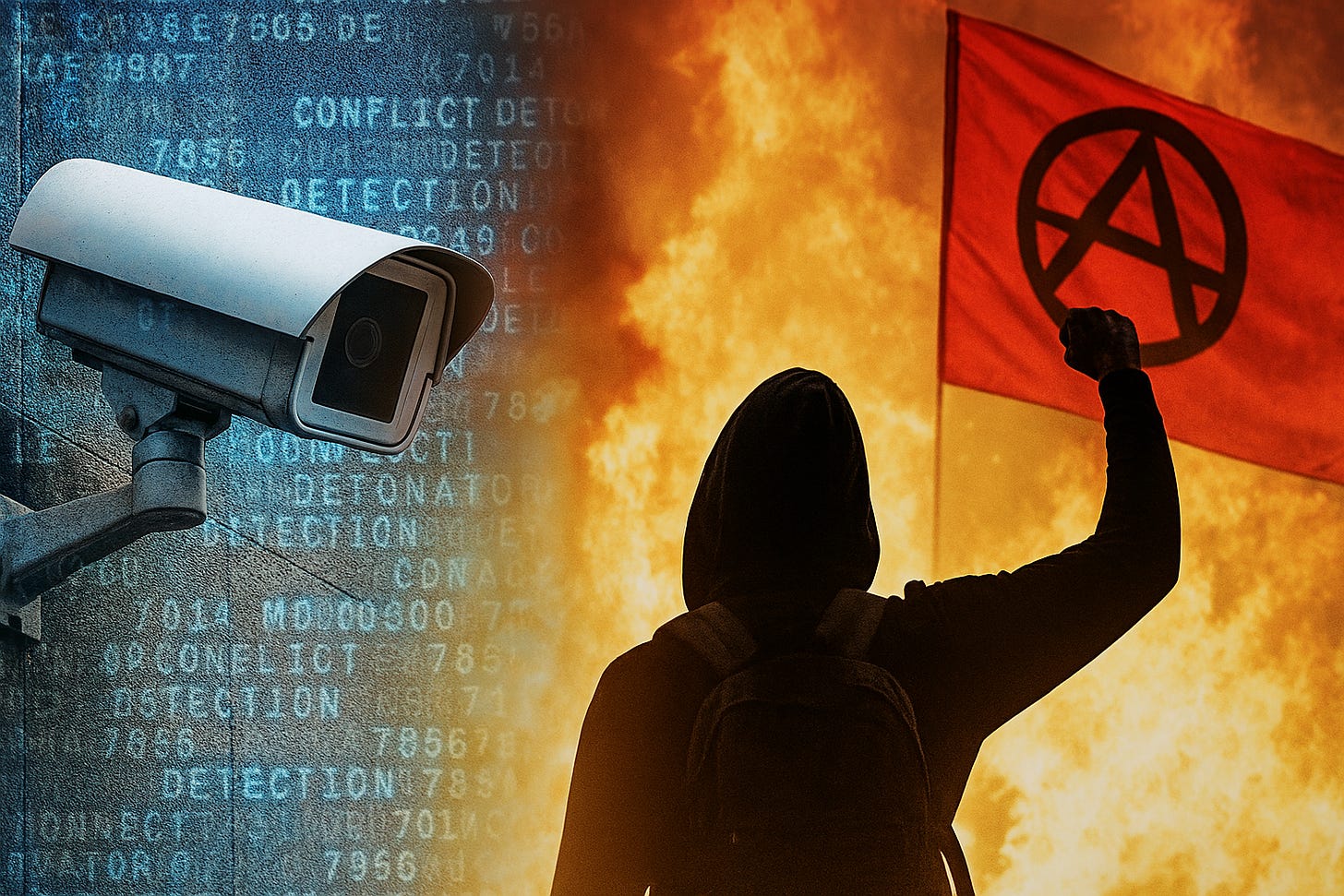Digital Breadcrumbs and Institutional Blindness
The Failure of State Surveillance in an Age of Political Violence
Tyler Robinson murdered Charlie Kirk after spending months broadcasting his intentions across multiple platforms. He accumulated 2,000 hours on VRChat, discussed assassination plans on Discord, and posted threats on social media. Despite leaving a trail any surveillance system should detect, he walked into a Utah university event and executed America’s most prominent young conservative.
This isn’t an anomaly. Trump has faced multiple assassination attempts. Texas has seen three separate anti-ICE facility attacks this year alone. ABC’s California offices were shot up. Each incident follows the same pattern: attackers announce their plans online, federal surveillance systems ignore the threats, and Americans die.
The technology exists to prevent these attacks. The same apparatus that tracked down January 6th participants from crowd photos somehow can’t spot explicit murder plots discussed on mainstream platforms. Our billion-dollar surveillance infrastructure works with lethal precision against conservatives but develops convenient blindness when the wrong side becomes the targets.
The Palantir Paradox
Alex Karp’s Palantir has secured massive government contracts positioning itself as America’s premier threat detection system. The company promises to synthesize vast amounts of data—social media posts, communications, financial records—to identify threats before they occur. They’re literally being paid to prevent another 9/11 type event through comprehensive monitoring of digital behavior.
Yet Tyler Robinson successfully assassinated one of America’s most prominent and beloved conservative figures after allegedly spending weeks to months planning on platforms that federal agencies routinely monitor. His VRChat activity should have generated algorithmic flags. His Discord communications should have been captured by keyword analysis. His social media posts should have triggered human review.
Instead, we get nothing. The same surveillance infrastructure that can predict what products you’ll buy next week somehow can’t flag someone posting explicit death threats against public figures. What exactly are we paying Palantir for? What threats are they actually catching if they miss teenagers announcing their intention to “liquidate” conservative leaders?
Technology That Only Works Sometimes
The surveillance ecosystem extends far beyond Palantir—NSA mass data collection, fusion centers, social media monitoring algorithms—none of it has prevented these attacks. Yet we know this technology works because we’ve seen it in action against the regime’s preferred targets—i.e. Palestinian children and so-called “far-right extremists”.
When January 6th participants posted on social media, hundreds were tracked down and prosecuted within months. The FBI demonstrated remarkable efficiency in identifying individuals from grainy photos and metadata analysis. The same investigative machinery that can hunt down Trump supporters through digital breadcrumbs mysteriously malfunctions when left-wing extremists make explicit threats and follow through with violence.
This isn’t technical failure—it’s selective enforcement. The surveillance state seems to perfectly when targeting Trump supporters but develops sudden blindness when the terrorists align with the politics being promulgated by our institutions.
Aren’t We Noticing A Pattern?
What makes this surveillance failure even more damning is the refusal to connect obvious dots. We’re not dealing with sophisticated terror cells using encrypted communications and operational security. These are college kids posting their activities on mainstream platforms, spending thousands of hours in public gaming environments, often times openly discussing their hatred for certain political figures.
These platforms generate massive amounts of data that Palantir and other state-sponsored surveillance companies claim to analyze for threat detection. Yet somehow, explicit discussions about “liquidating” public figures slip through their billion-dollar algorithms.
This is hardly a problem of capability. The same agencies that can track down January 6th participants through grainy photos and social media posts claim they can’t identify threats from people posting explicit intentions to commit political violence. The surveillance apparatus works flawlessly when the targets align with our institutions, but mysteriously fails when they don’t.
The Impossible Double Standard
Here’s what should terrify every American: imagine if the political alignment were reversed. Picture right-wing extremists assassinating a major progressive figure, attempting to kill a Democratic presidential candidate multiple times, conducting three separate attacks on federal facilities, and shooting up a major media outlet—all while posting their intentions online. We’d be living under martial law within days. Mass arrests, expanded surveillance powers, and a complete crackdown on “domestic terrorism” would follow immediately. The response would be swift, overwhelming, and totalitarian in scope.
Instead, we get silence. No connections drawn between incidents. No acknowledgment of a pattern. No emergency response from agencies supposedly dedicated to preventing domestic terrorism. The contrast reveals the true nature of our supposedly neutral bureaucracy and its weaponization to protect the regime’s allies while criminalizing their political opposition.
The Escalation Machine
Every successful attack creates copycat potential. Every schizo nut-job watching these stories unfold sees a path to notoriety. The media coverage, the muted official responses, the lack of serious investigation—all of it feeds into a feedback loop that all but guarantees more violence.
This creates a disturbing dialectic between chaos and order. When citizens feel unsafe, they beg for more government control, more surveillance, more restrictions on civil liberties. Every terrorist attack becomes justification for expanded state power.
The question becomes: is this organic left-wing terrorism that our surveillance state genuinely can’t stop, or is there something more calculated happening? Are they allowing the situation to deteriorate until Americans demand the totalitarian measures that would otherwise face resistance?
The Fundamental Question
We’re being presented with two terrible options: continue watching ideologically motivated killers pick off innocent Americans while posting their intentions online, or surrender what remains of our privacy to a surveillance apparatus that’s already proven it won’t protect us when it matters.
The government that covered up Epstein, that’s been thoroughly penetrated by foreign interests, that uses our data for political targeting—this same government wants us to trust them with backdoors into every device we use. They’re going to try to make us believe that more surveillance will solve the problem, even as billions already spent on surveillance technology fails to stop woke nut-jobs planning political violence on Discord chat.
Before we make any rash decisions about expanding surveillance powers, we need to understand what’s really happening. The pattern of left-wing terrorism is undeniable. The selective enforcement is obvious. The institutional protection of blatant terrorism is becoming all too common.
The terrorists aren’t winning by accident. They’re being allowed to win. And until we acknowledge that our billion-dollar surveillance apparatus is a weapon pointed at half of America while protecting the other half’s killers, more Americans will die while our government watches from the sidelines.



